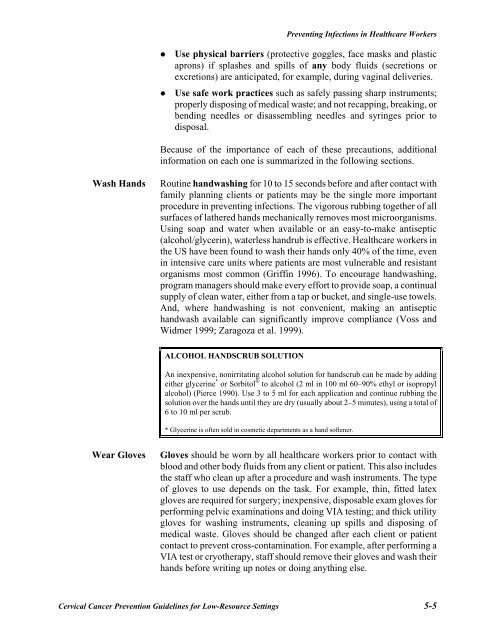Reference Manual - IARC Screening Group
Reference Manual - IARC Screening Group
Reference Manual - IARC Screening Group
You also want an ePaper? Increase the reach of your titles
YUMPU automatically turns print PDFs into web optimized ePapers that Google loves.
Preventing Infections in Healthcare Workers• Use physical barriers (protective goggles, face masks and plasticaprons) if splashes and spills of any body fluids (secretions orexcretions) are anticipated, for example, during vaginal deliveries.• Use safe work practices such as safely passing sharp instruments;properly disposing of medical waste; and not recapping, breaking, orbending needles or disassembling needles and syringes prior todisposal.Because of the importance of each of these precautions, additionalinformation on each one is summarized in the following sections.Wash HandsRoutine handwashing for 10 to 15 seconds before and after contact withfamily planning clients or patients may be the single more importantprocedure in preventing infections. The vigorous rubbing together of allsurfaces of lathered hands mechanically removes most microorganisms.Using soap and water when available or an easy-to-make antiseptic(alcohol/glycerin), waterless handrub is effective. Healthcare workers inthe US have been found to wash their hands only 40% of the time, evenin intensive care units where patients are most vulnerable and resistantorganisms most common (Griffin 1996). To encourage handwashing,program managers should make every effort to provide soap, a continualsupply of clean water, either from a tap or bucket, and single-use towels.And, where handwashing is not convenient, making an antiseptichandwash available can significantly improve compliance (Voss andWidmer 1999; Zaragoza et al. 1999).ALCOHOL HANDSCRUB SOLUTIONAn inexpensive, nonirritating alcohol solution for handscrub can be made by addingeither glycerine * or Sorbitol ® to alcohol (2 ml in 100 ml 60–90% ethyl or isopropylalcohol) (Pierce 1990). Use 3 to 5 ml for each application and continue rubbing thesolution over the hands until they are dry (usually about 2–5 minutes), using a total of6 to 10 ml per scrub.* Glycerine is often sold in cosmetic departments as a hand softener.Wear GlovesGloves should be worn by all healthcare workers prior to contact withblood and other body fluids from any client or patient. This also includesthe staff who clean up after a procedure and wash instruments. The typeof gloves to use depends on the task. For example, thin, fitted latexgloves are required for surgery; inexpensive, disposable exam gloves forperforming pelvic examinations and doing VIA testing; and thick utilitygloves for washing instruments, cleaning up spills and disposing ofmedical waste. Gloves should be changed after each client or patientcontact to prevent cross-contamination. For example, after performing aVIA test or cryotherapy, staff should remove their gloves and wash theirhands before writing up notes or doing anything else.Cervical Cancer Prevention Guidelines for Low-Resource Settings 5-5
















